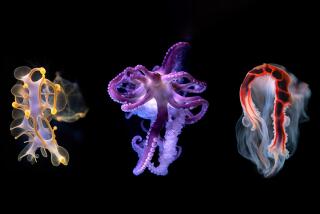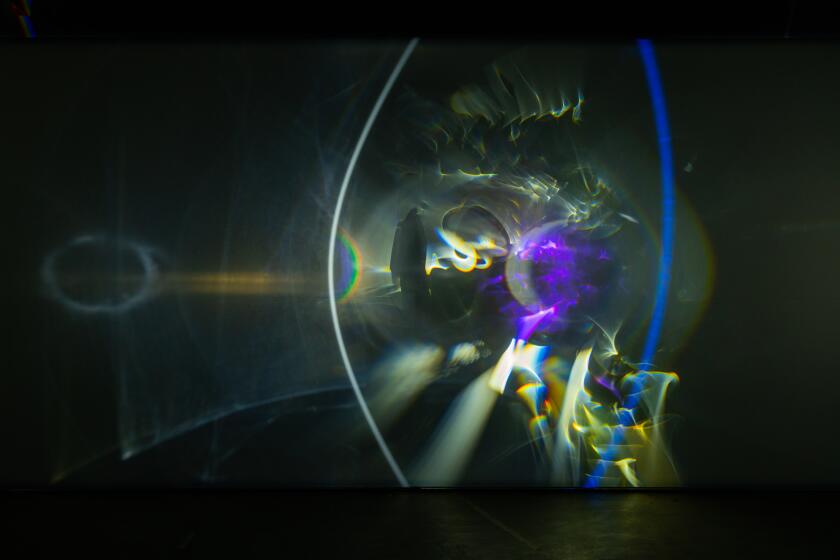Santa Barbara Museum of Art reflects on ‘The Artful Recluse’
SANTA BARBARA — Chinese scrolls often show landscapes of mountains, deep-cut gorges and paths that spiral through them and past caves in foliage. On these paths, often barely visible, smallish robed figures walk alone or sit in a group. Even people relatively familiar with this kind of art have peered at the finely drawn figures and wondered: Who are they? What are they up to?
The Santa Barbara Museum of Art is offering an unusually comprehensive answer to such questions with a far-reaching show called “The Artful Recluse: Painting, Poetry, and Politics in 17th Century China.” Consisting of 57 works, including scrolls that lie flat in long display cases and tall scrolls hanging against breezily elegant green-blue walls that reflect the rural setting of many pictures, the exhibition charts a new road through a vast, ancient subject. For these works, drawn from museums in this country, private collections and the National Palace Museum in Taiwan, resonate with a theme that has filtered through Chinese culture for centuries in ways “as familiar as Christianity in the West.”
So says Peter Sturman, a professor of Asian art and architecture history at UC Santa Barbara who co-curated the show with Susan Tai, the museum’s curator of Asian art. Of this Chinese reclusion, he adds: “It is not a religion but involves spirituality. It ties deeply into Taoism, Confucianism and Buddhism. It is a way through which, in the 17th century, people could be disengaged but communicate their most important inner feelings in a time of crisis.”
Two large subdivided rooms hold pieces by 42 different artists who lived before, during and after the collapse of the almost 300-year Ming Dynasty between 1600 and 1644, including the invasion of the Manchus and the establishment of a new dynasty, the Manchu-ruled Qing (pronounced Ching). To see their work affirms yet again the saying that the winners of historical conflicts write the history and the losers create the culture. This group of so-called literati was a dispossessed elite of scholar-officials associated with the Ming who had mastered painting, poetry and calligraphy, then used them to respond to trauma.
They fled to the hills, in fact and in their imaginations, seeking withdrawal and expressing it in a kaleidoscopic variety of styles. The landscapes, typically ink on paper or silk, often black and white but also with color, range from wistful lightness to rugged gloom.
The show begins with the brilliant, fluidly intricate scroll that Sturman says inspired him to push beyond the smaller exhibition first planned. It’s called “Invitation to Reclusion,” and he renewed his acquaintance with it in 2010 upon taking students to the Los Angeles County Museum of Art as part of a seminar on the 17th century. “They pulled it out and it was visually compelling,” Sturman recalled. “It became our beacon as we developed the show.”
The artist was Xiang Shengmo, who made the 43-foot-long work in his 20s around 1625. To the far right stands the reclusion seeker, starting his journey. He meets a master recluse who, Sturman says, will guide him. Xiang included 20 poems that often explore disengagement as a way to reengage. In one, he asks: “Who says reclusive living need be remote?”
Sturman was also taken by diaristic accounts Xiang wrote beside the poems about his anxious artistic process and exchanges he had with the artist Dong Qichang, a Michelangelo-scaled titan of the era. A golden-hued nature piece by Dong appears nearby. He inscribed it with Taoist-inspired words about the pure joy of making art. Other works embrace the reclusions of nature, art, religious practice and sensuality. Xue Wu, one of two literati-associated women in the show, painted a scroll called “Wild Orchids,” languorous eruptions of long-leaved flowers.
Many literati committed suicide — “the ultimate form of reclusion,” Sturman notes. Others adapted over time, and would reconcile with the Qing and regain the literati’s winner status.
Leading the way through their show, Sturman and Tai — he provided more of the scholarly drive and she the organizational ideas — demonstrated a digital station with screens in which “Wild Orchids” and other scrolls can be followed to a fuller length than they can be shown. Then it was over to a quite large “Self-Portrait in Red Landscape” that Xiang did of himself about 20 years after “Invitation to Reclusion,” sitting under a leafy reddish canopy. The color symbolizes the Ming dynasty, Sturman says.
A poem by Xiang hovers above him: “Men of mark are few and desolate.”
The show concludes with the work of Shitao, an artist who ultimately met the new Qing reality at the start of the 18th century with a display of what Sturman calls “opportunistic” confidence. His huge 12-panel piece, a close-up of a sort of garden, is called “Plants of Virtue and Rocks By Water.” It’s one of the two or three works that Tai says will most strongly draw connoisseurs. Lent by the National Palace Museum in Taipei, it appears in this country for the first time.
There have been other shows about the 17th century literati, but several art historians couldn’t think of another that pursued the reclusion theme to this extent.
The reason, Sturman says, is that the universe of this kind of purposeful solitude is so familiar to Chinese art historians that it’s taken for granted. Larry Feinberg, director of the Santa Barbara museum, says the duo’s rediscovery of the theme is making this the first self-developed show in the museum’s 71 years to travel to New York, where it opens at the Asia Society next March. It runs in Santa Barbara through Jan. 20. Feinberg calls the transfer “a milestone in our plan to expand our role as a regional museum that does shows of national and international value.”
Adriana Proser, an Asia Society curator, says: “We wanted it here because of the quality of individual pieces but also because of its innovative scholarship in taking what we who work in this area know very well and framing it in a way that gives new depth to its meaning and history.”
The Metropolitan Museum of Art took a serious look at taking the show, but it followed too closely on another exhibition about China’s 17th century, according to Maxwell Hearn, curator in charge of the Met’s Department of Asian Arts. He, too, says the show’s focus on reclusion is distinctive.
Hearn and Proser also speak of the show’s relevance as one watches the political tensions in China today. Hearn says its theme prompts one to wonder anew: “How does the individual behave in a complex society where the powers of the individual to protest are limited?”
More to Read
The biggest entertainment stories
Get our big stories about Hollywood, film, television, music, arts, culture and more right in your inbox as soon as they publish.
You may occasionally receive promotional content from the Los Angeles Times.










